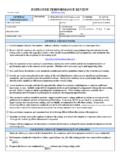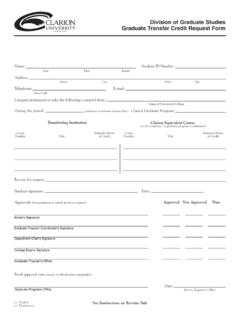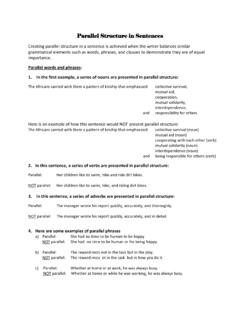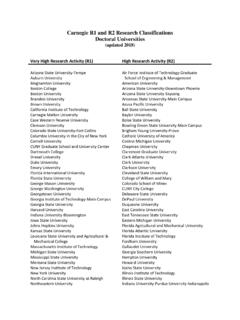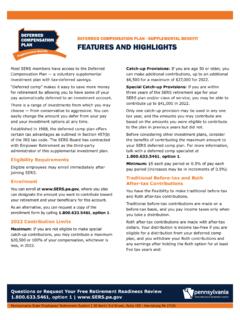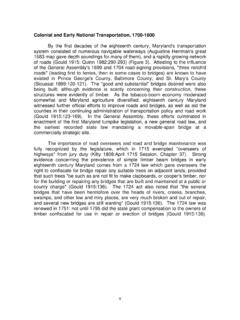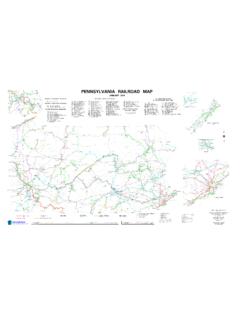Transcription of Sample Industry Analysis - Clarion University of …
1 Sample Industry AnalysisThis report contains an example of what you can expect if you request the services of the Clarion University Small Business Development this report: Industry Analysis reports contain a wealth of information specific to Industry type. This includes current trends, opportunities, threats, challenges, and critical issues. They also contain financial benchmark information that may be used for comparison against those in the Industry . This report is a critical component of understanding the current state of a given Industry . The SBDC has access to all 500 Industry CODES: 33271 SIC CODES: 3599 Industry PROFILEM achine ShopsCompanies in this Industry use machine tools to modify metal, plastic, and composite materials to producefinished products.
2 No major companies dominate the , revenue for machine shops varies with manufacturing output. Because machine shops play amanufacturing support role, often operating as de facto subsidiaries of their customers, their work tends to US machine shop Industry includes about 20,000 companies with combined annual revenue of about $ depends on manufacturing activity. The profitability of individual companies is linked to engineeringexpertise and operating efficiency. Larger shops have the ability to invest in advanced production shops can compete effectively by serving specialized customers, or by providing engineering US Industry is highly fragmented: the 50 largest companies generate about 10% of shops are intermediaries in industrial production: generally, they receive unfinished parts or rawmaterials from a manufacturer, perform various operations, and return the parts to the manufacturer for furtherprocessing.
3 They own and operate special machine tools that can perform a variety of operations, includingdrilling; boring (enlarging an existing hole); tapping (cutting threads inside a drilled hole); threading (cutting threadson a bolt); cutting; milling (removing material from a surface); and grinding (usually a finishing operation). Theseoperations involve material removal, frequently with great precision. The bulk of machine shop work is performedon metal, but plastics and composite materials are also machines that perform these operations are usually expensive and often computer-controlled. Machinetools vary by the type of operation they perform, the size of a piece they process, and the precision of theiroperations.
4 Many are operated with computer numerical controls (CNC). Machine shops may own dozens ofdifferent machine tools produced by a variety of manufacturers. Modern machine shops are highly automated,with computer programs aiding the design of parts, as well as controlling the machines that are used tomanufacture them. Parts may be moved from one machine to another manually or using robotics. Aside from afew US companies, many major machine tool makers are German, Japanese, or the methods for machining have become more technologically complex, so too have the tools for managingshop operations. Many providers of customer relationship management (CRM) and enterprise resourceplanning (ERP) software, particularly those aimed at the small and mid-size business segments, offer applicationsuites tailored for the manufacturing sector.
5 There are also software vendors dedicated specifically todeveloping tools for managing machine shop processes. Such software can help businesses submit bids, ordermaterials, schedule jobs, manage inventory, and track major operating activities in machine shops are pre-production, machine setup, actual production, andquality control. Machine setup for a particular job can be time-consuming and can hugely affect costs. Majormaterial costs for machine shops are the expensive, specially hardened l bits consumed in the variousoperations, including drilling bits, milling heads, cutting tools, and machine shops are expected to invest in robotics to enhance productivity, reduce operating costs, andIndustry OverviewCompetitive LandscapeProducts, Operations & Technologyincrease competitiveness.
6 north American industrial robot shipments rose 10% in 2016 over 2015 levels,according to the Robotic Industries manufacturing, also known as 3D printing, is another technology with applications in machine manufacturing produces solid, three-dimensional objects by successively layering materials according toa digital design. Hybrid machine tools are being developed that combine additive and subtractive (cutting, milling,turning, and grinding) manufacturing technologies to offer machinery capable of a wider variety of parts withcomplex geometric for machine shops consists largely of direct contacts with local manufacturers. Because of the needfor close technical consultation between machine shops and customers, the work of most machine shops isusually confined to a very local area.
7 New business may also come through requests for proposals (RFPs)from manufacturers familiar with the company. Customers can be in a wide variety of manufacturing work is local, companies often have a large concentration of customers in the same end-users include the aerospace, automotive, chemical, electronics, medical, oil and gas, and industrialmachinery industries. New work is often acquired through job bidding. While pricing is always a considerationfor new business, product quality and the ability to meet production timetables are often of greater expertise is very important in properly pricing a bid, since the workability of materials, thecomplexity of machine setup, and the capabilities of individual pieces of machinery can vary shops have large investments in machinery and equipment, including drill presses; lathes (turningmachines); and milling and grinding machines.
8 Individual pieces of equipment may cost several hundredthousand dollars and can often be bought with financing provided by the manufacturer. On average, capitalexpenditures represent about 5% of sales. The Industry is labor-intensive: average annual revenue peremployee is about $135, US Industry 's working capital turnover ratio averages about 25%. Shops generally don't have largeinvestments in inventory, because customers typically provide materials. There is very little seasonality inproduction or cash flow, but the Industry is susceptible to customer work stoppages and economic cycles, whichcan produce highly uneven and unpredictable cash flow. The value of inventory is usually about 10% of sales,and inventories turn about six times per year.
9 Machine shop inventories tend to be split evenly between finishedgoods, work-in-progress, and raw for machining services depends on the level of US manufacturing activity, which can vary significantlyfrom year to year. Many machine shops depend directly on the health of a single end-use Industry . The machineshop Industry gets large amounts of business from the auto and aircraft industries and electronics and industrialmachinery producers. If a major customer or Industry group closes or moves manufacturing operations, localmachine shops may experience a precipitous drop in demand, and collection periods and questionable accountsmay increase. Accounts receivable average about 50 days, but collection periods tend to be longer for smallercompanies (under $5 million in annual sales).
10 Working Capital Turnover by Company SizeThe working capital turnover ratio, also known as working capital to sales, is a measure ofhow efficiently a company uses its capital to generate sales. Companies should becompared to others in their Industry . Sales & MarketingFinance & Regulation RegulationBecause of the nature of working with metals, including the use of lubricants and solvents and the production ofsizable amounts of metallic wastes, machine shops can have environmental pollution problems, particularly withregard to ground contamination and toxic waste disposal. Some types of machining operations can alsorelease fine particles into the air, creating hazardous workplace conditions unless proper control steps are EPA administers environmental pollution regulations; OSHA administers workplace global machine shop Industry is dependent on the level of international manufacturing activity.
